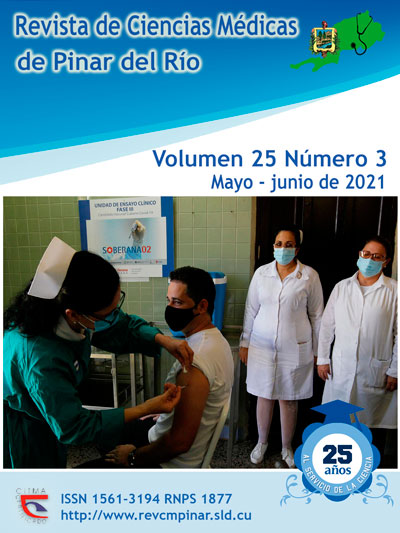Triage and the route of care for pediatric patients in times of Covid-19, Pinar del Rio
Keywords:
TRIAGE, CORONAVIRUS INFECTIONS, PATIENT CARE, CHILD, DISEASE PREVENTION.Abstract
Introduction: in the framework of Covid-19 pandemic the structured triage is an indispensable element to prioritize and define the route of care, guaranteeing a timely assistance which could reduce the exposure of the healthcare personnel and consequently, the spreading of the disease.
Objective: to establish recommendations for the triage and to determine the route of care for pediatric patients attending Pepe Portilla Pediatric Teaching Hospital in the context of Covid-19 pandemic.
Development: particularities in the route of care are introduced considering the pediatric triage, structured by means of the assessment of the triangle used for pediatric evaluation; in addition to the definition for a suspected case of Covid-19, as a basic process for the preliminary-clinical-evaluation in emergency services and establishing two flows of patients: flow 1- suspected case of Covid-19 and flow 2- not suspected case of Covid-19.
Conclusions: the recommendations described are general and each hospital, depending on its characteristics, should decide the most favorable organization to guarantee a care of quality along with the safety of inpatients and outpatients.
Downloads
References
1. Coronavirus en Cuba, 1 de febrero de 2021 [Internet]. Cecmed. [citado 28/02/2021]. Disponible en: https://www.cecmed.cu/noticias/coronavirus-cuba-1-febrero-2021
2. Wu Z, McGoogan JM. Characteristics of and Important Lessons From the Coronavirus Disease 2019 (COVID-19) Outbreak in China: Summary of a Report of 72 314 Cases From the Chinese Center for Disease Control and Prevention. JAMA[Internet]. 2020 [citado 28/02/2021]; 323(13): 1-4 Disponible en: https://www.semanticscholar.org/paper/Characteristics-of-and-Important-Lessons-From-the-a-Wu-McGoogan/97881c6577c310f50fc86738c0268896b970dfa4
3. Jiehao C, Jin X, Daojiong L, Zhi Y, Lei X, Zhenghai Q, et al. A case series of children with 2019 novel Coronavirus infection: Clinical and epidemiological features. Clin Infect Dis. [Internet]. 2020 [citado 28/02/2021]; 71(6): 1547-51. Disponible en: https://academic.oup.com/cid/article/71/6/1547/5766430
4. Wuhan Union Hospital, Huazhon University et all. Care of Pediatric Patients during COVID-19 Pandemic. Wuhan United “Living Through a Pandemic” Series 4. [Internet]. 2020 [citado 28/02/2021]. Disponible en: http://hcpnutramigenhusky-dev.eu-west-1.elasticbeanstalk.com/media/1016/slides-for-care-of-pediatric-patients-during-covid-19-pandemic-04042020.pdf
5. Fernández A, Benito J, Mintegi S. Is this child sick? Usefulness of the Pediatric Assessment Triangle in emergency settings. J Pediatr (Rio J). [Internet]. 2017 [citado 28/02/2021]; 93(Suppl 1): 60-7. Disponible en: https://www.scielo.br/j/jped/a/5d8m7zZKJXcwDV9YM8cgFHx/?lang=en
6. Dieckmann RA, Brownstein D, Gausche-Hill M. The Pediatric Assessment Triangle: A novel approach to pediatric assessment. Pediatr Emerg Care. [Internet]. 2010 [citado 28/02/2021]; 26(4): 312–15. Disponible en: https://pubmed.ncbi.nlm.nih.gov/20386420/
7. Guía de tratamiento de adultos con enfermedad por Coronavirus (SARS-CoV-2) [Internet]. Hospital Universitario. 12 de octubre 2020 [citado 28/02/2021]. Disponible en: https://www.semes.org/wp-content/uploads/2020/03/3.-12-DE-OCTUBRE.pdf
8. Triaje y Ruta de Atención del PACIENTE PEDIÁTRICO en la pandemia COVID-19 [Internet]. Unicef.org. 2020 [citado 28/02/2021]. Disponible en: https://www.unicef.org/ecuador/informes/triaje-y-ruta-de-atenci%C3%B3n-del-paciente-pedi%C3%A1trico-en-la-pandemia-covid-19
9. Actualización de las recomendaciones de la OMS para el uso de mascarillas en el contexto de la COVID-19, tanto en la comunidad como en los centros sanitarios y en la atención domiciliaria - semFYC [Internet]. Semfyc.es. [citado 29/02/2021]. Disponible en: https://www.semfyc.es/grupos/actualizacion-de-las-recomendaciones-de-la-oms-para-el-uso-de-mascarillas-en-el-contexto-de-la-covid-19-tanto-en-la-comunidad-como-en-los-centros-sanitarios-y-en-la-atencion-domiciliaria/
10. Recomendaciones de la SEUP sobre la organización de la asistencia en Urgencias Pediátricas en relación con la infección por SARS-CoV-2 [Internet]. Aeped.es. 2020 [citado 28/02/2021]. Disponible en: https://www.aeped.es/noticias/recomendaciones-seup-sobre-organizacion-asistencia-en-urgencias-pediatricas-en-relacion-con
11. Documento de manejo clínico del paciente pediátrico y pacientes de riesgo con infección por SARS-CoV2 [Internet]. Aeped.es. 2020 [citado 28/02/2021]. Disponible en: https://www.aeped.es/noticias/documento-manejo-clinico-paciente-pediatrico-y-pacientes-riesgo-con-infeccion-por-sars-cov2
12. García-Salido A, Antón J, Martínez-Pajares JD, Giralt Garcia G, Gómez Cortés B, Tagarro A, et al. Documento español de consenso sobre diagnóstico, estabilización y tratamiento del síndrome inflamatorio multisistémico pediátrico vinculado a SARS-CoV-2 (SIM-PedS). An Pediatr (Barc). [Internet]. 2021[citado 28/02/2021]; 94(2): 116.e1-116.e11 Disponible en: https://www.analesdepediatria.org/es-pdf-S1695403320304197
13. Velasco Zúñiga R. Triángulo de Evaluación Pediátrica. Pediatr Integral [Internet]. 2014 [citado 28/02/2021]; XVIII (5): 320-323. Disponible en: https://www.pediatriaintegral.es/wp-content/uploads/2014/xviii05/05/320-323.pdf
14. Fernández Arribas JL. Aproximación y estabilización inicial del niño enfermo o accidentado. Triángulo de evaluación pediátrica. ABCDE. Protoc diagn ter pediatr. [Internet]. 2020 [citado 28/02/2021]; 1: 15-26. Disponible en: https://www.aeped.es/sites/default/files/documentos/02_tep_abcde.pdf
15. Protocolo de actualización Nacional para la COVID-19. La habana [citado 29/02/2021]. 2021 Disponible en: https://files.sld.cu/editorhome/files/2021/03/VERSION_FINAL_6_EXTENDIDA_PROTOCOLO_REVISADA_28_MARZO__2021.pdf
Downloads
Published
How to Cite
Issue
Section
License
Authors who have publications with this journal agree to the following terms: Authors will retain their copyrights and grant the journal the right of first publication of their work, which will be publication of their work, which will be simultaneously subject to the Creative Commons Attribution License (CC-BY-NC 4.0) that allows third parties to share the work as long as its author and first publication in this journal are indicated.
Authors may adopt other non-exclusive license agreements for distribution of the published version of the work (e.g.: deposit it in an institutional telematic archive or publish it in a volume). Likewise, and according to the recommendations of the Medical Sciences Editorial (ECIMED), authors must declare in each article their contribution according to the CRediT taxonomy (contributor roles). This taxonomy includes 14 roles, which can be used to represent the tasks typically performed by contributors in scientific academic production. It should be consulted in monograph) whenever initial publication in this journal is indicated. Authors are allowed and encouraged to disseminate their work through the Internet (e.g., in institutional telematic archives or on their web page) before and during the submission process, which may produce interesting exchanges and increase citations of the published work. (See The effect of open access). https://casrai.org/credit/



